“The bun-sellers or cake-makers were in nothing inclinable to their request; but, which was worse, did injure them most outrageously, calling them prattling gabblers, lickorous gluttons, freckled bittors, mangy rascals, shite-a-bed scoundrels, drunken roysters, sly knaves, drowsy loiterers, slapsauce fellows, slabberdegullion druggels, lubberly louts, cozening foxes, ruffian rogues, paltry customers, sycophant-varlets, drawlatch hoydens, flouting milksops, jeering companions, staring clowns, forlorn snakes, ninny lobcocks, scurvy sneaksbies, fondling fops, base loons, saucy coxcombs, idle lusks, scoffing braggarts, noddy meacocks, blockish grutnols, doddipol-joltheads, jobbernol goosecaps, foolish loggerheads, flutch calf-lollies, grouthead gnat-snappers, lob-dotterels, gaping changelings, codshead loobies, woodcock slangams, ninny-hammer flycatchers, noddypeak simpletons, turdy gut, shitten shepherds, and other suchlike defamatory epithets; saying further, that it was not for them to eat of these dainty cakes, but might very well content themselves with the coarse unranged bread, or to eat of the great brown household loaf.”
– François Rabelais, Gargantua and Pantagruel, 1532
Buenos Aires – You might ask just exactly why I’m quoting a rather verbose, yet clearly creative, 16th Century Franciscan monk from France. You might. But why bother? Just look at it – the prose is worth the read – of course, when it comes down to it, I imagine Rabelais wrote in French and this collection of insults is the translator’s (Sir Thomas Urquhart) version of the original. But why, again? Because the other day at lunch found my friend Michael and I popping in to a small brasserie that we’d seen in Recoleta, by the name of Rabelais, Libertad 1319 (4515-0640) [This place closed in early 2010.]. It’s an intriguing looking venue from the outside, having a sort of French country charm sort of look, and upon entering, we found it to be beautifully appointed – an interesting mix of rustic wood walls, fine linen tablecloths and napkins, and dotted with caricatures of French politicians on the walls (I swear the caricature of De Gaulle, at first glance, could have been Adolf Hitler…). The menu, a large leather bound affair, is written in a strange mix of French and Castellano – as if there were certain dishes that the owner or chef just couldn’t bring themselves to change the names of from the original, and others they just simply translated. The staff were friendly and efficient, and the owner was on hand to greet patrons and schmooze the dining room.
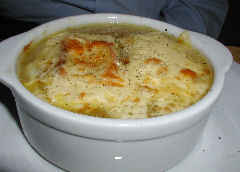 The menu apparently doesn’t get changed very often, as we swiftly discovered when Michael ordered the fresh vegetable gazpacho. Our waiter sadly shook his head and commented that while it’s always on the menu, it’s only available in spring and summer, not the rest of the year. However, they were offering a classic French onion soup which he highly recommended. Neither of us is usually fond of classic French onion soup – it’s rarely well made, generally heavy, with onions not properly cooked, and often a rather overbearing beef broth, as if someone sauteed a few onions, tossed them into a pot of stock, and stuck slice of toast with a mound of cheese on top. Not this one – delicate, flavorful, with onions sweated until perfectly transluscent and meltingly soft, the broth probably a light veal stock with a touch of wine or vermouth, the cheese, just enough to create a thin, bubbly crust.
The menu apparently doesn’t get changed very often, as we swiftly discovered when Michael ordered the fresh vegetable gazpacho. Our waiter sadly shook his head and commented that while it’s always on the menu, it’s only available in spring and summer, not the rest of the year. However, they were offering a classic French onion soup which he highly recommended. Neither of us is usually fond of classic French onion soup – it’s rarely well made, generally heavy, with onions not properly cooked, and often a rather overbearing beef broth, as if someone sauteed a few onions, tossed them into a pot of stock, and stuck slice of toast with a mound of cheese on top. Not this one – delicate, flavorful, with onions sweated until perfectly transluscent and meltingly soft, the broth probably a light veal stock with a touch of wine or vermouth, the cheese, just enough to create a thin, bubbly crust.
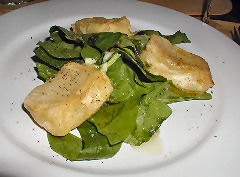 I can be talked into cheese at virtually any time of any day. In its seemingly endless varieties, I can find inordinate pleasure. Pair it with a salad and some good bread, and I’m a happy camper. So an arugula salad with lightly warmed Camembert sounded perfect to me. I won’t claim that it was perfection incarnate, but it was darned good. Three nice sized blocks of ripe Camembert, lightly dusted with flour and toasted, the cheese all melty and gooey inside its crust, the salad lightly dressed with a simple vinegar and oil vinaigrette – the waiter actually offered to grind a bit of pepper on it, and the soup, rather than the usual here of dropping the grinder off at the table and walking away. Service, folks, service.
I can be talked into cheese at virtually any time of any day. In its seemingly endless varieties, I can find inordinate pleasure. Pair it with a salad and some good bread, and I’m a happy camper. So an arugula salad with lightly warmed Camembert sounded perfect to me. I won’t claim that it was perfection incarnate, but it was darned good. Three nice sized blocks of ripe Camembert, lightly dusted with flour and toasted, the cheese all melty and gooey inside its crust, the salad lightly dressed with a simple vinegar and oil vinaigrette – the waiter actually offered to grind a bit of pepper on it, and the soup, rather than the usual here of dropping the grinder off at the table and walking away. Service, folks, service.
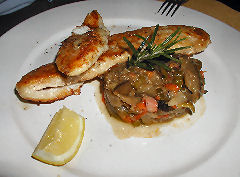 Michael opted for a plate of simple grilled sole. Now, we’d both say that these flaky, juicy, simply grilled couple of fillets, accompanied by a ratatouille with added mushrooms, was delicious. Neither of us would like agree that it was actually sole. The fish was too thick, the fillets too narrow. It was good quality fish, but the shape was just wrong to have been sole. Hard to say what it was, possibly something like merluza, or hake. Still, it really was quite good – perhaps they didn’t get any sole in that day and were just daring a substitute without mentioning it.
Michael opted for a plate of simple grilled sole. Now, we’d both say that these flaky, juicy, simply grilled couple of fillets, accompanied by a ratatouille with added mushrooms, was delicious. Neither of us would like agree that it was actually sole. The fish was too thick, the fillets too narrow. It was good quality fish, but the shape was just wrong to have been sole. Hard to say what it was, possibly something like merluza, or hake. Still, it really was quite good – perhaps they didn’t get any sole in that day and were just daring a substitute without mentioning it.
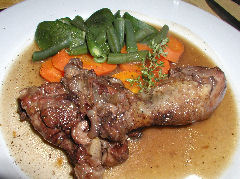 When I was in cooking school, somewhere in the midst of my culinary career, one of our instructors said that there were three true tests of a French chef’s skills – a basic vinaigrette, a coq au vin, and a tarte tatin – if they can prepare those well, they can cook anything. I’d covered the vinaigrette with the Camembert salad, and it was good, and the salad properly dressed. I think somehow, without thinking, I keep that series of tests in the back of my mind when I enter a French restaurant, as, without consideration, I ordered the coq au vin, and later the tarte tatin. It doesn’t look like much on the plate – a simple leg and thigh of chicken, purpley-red from the wine, a small pile of carrots and beans – but you know what? The chicken was cooked just right – tender and juicy, yet completely cooked through; the sauce, so good that I mopped it up with bread; the vegetables, cooked, but crisp. Dead on.
When I was in cooking school, somewhere in the midst of my culinary career, one of our instructors said that there were three true tests of a French chef’s skills – a basic vinaigrette, a coq au vin, and a tarte tatin – if they can prepare those well, they can cook anything. I’d covered the vinaigrette with the Camembert salad, and it was good, and the salad properly dressed. I think somehow, without thinking, I keep that series of tests in the back of my mind when I enter a French restaurant, as, without consideration, I ordered the coq au vin, and later the tarte tatin. It doesn’t look like much on the plate – a simple leg and thigh of chicken, purpley-red from the wine, a small pile of carrots and beans – but you know what? The chicken was cooked just right – tender and juicy, yet completely cooked through; the sauce, so good that I mopped it up with bread; the vegetables, cooked, but crisp. Dead on.
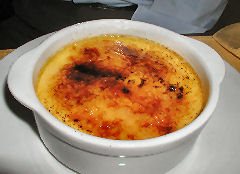 I’m afraid I’m guilty of talking Michael into ordering the creme brulee, despite the fact that it was nearly double the price of the flan casero. The ingredients in the two are basically the same, in differing proportions, though the brulee tends to be far more delicate. The price differential was a bit excessive (17 versus 9 pesos!), but it was worth a try. The custard was just lightly warmed, the crackly sugar top clearly just torched, this was an excellent version of the dessert. A minor quibble that it was a rather large portion – I guess I shouldn’t quibble given the price, but it was an awfully thick layer of the custard, and a big dish – personally, I’d cut the size of this way back and reduce the price to something more in line with the other desserts.
I’m afraid I’m guilty of talking Michael into ordering the creme brulee, despite the fact that it was nearly double the price of the flan casero. The ingredients in the two are basically the same, in differing proportions, though the brulee tends to be far more delicate. The price differential was a bit excessive (17 versus 9 pesos!), but it was worth a try. The custard was just lightly warmed, the crackly sugar top clearly just torched, this was an excellent version of the dessert. A minor quibble that it was a rather large portion – I guess I shouldn’t quibble given the price, but it was an awfully thick layer of the custard, and a big dish – personally, I’d cut the size of this way back and reduce the price to something more in line with the other desserts.
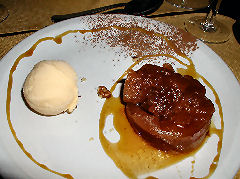 As I mentioned above, I just sort of automatically ordered the tarte tatin. It also happens to be one of my favorite desserts, especially when made well. This one was. The apples were deliciously caramelized, no spicing, just apple. A bit of a caramel sauce, and a scoop of intense vanilla gelato. The dish worked! And a properly sized portion as well.
As I mentioned above, I just sort of automatically ordered the tarte tatin. It also happens to be one of my favorite desserts, especially when made well. This one was. The apples were deliciously caramelized, no spicing, just apple. A bit of a caramel sauce, and a scoop of intense vanilla gelato. The dish worked! And a properly sized portion as well.
Obviously, I, we, liked the place. The food is exactly what a French brasserie should be offering, and it’s cooked by someone who clearly knows what they’re doing. I’ve got to say, however, that it’s pricey as hell. For a casual setting, and simple, though tasty, dishes, and a couple of glasses of wine (which all run 10-15 pesos a glass, high for this town) – we spent 80 pesos apiece on lunch. Not something I’d want to do on any regular basis, at either lunch or dinner. The place is there, and I’ll keep it in mind for a special evening out now and again, but it’s out of line for routine visits. I leave the final words to Rabelais, once again, his last will and testament, and his apparent actual final words…
“I have nothing, I owe a great deal, and the rest I leave to the poor.” and “I am off in search of a great perhaps.”
[…] Of course, you all remember my visit to the local French brasserie, Rabelais and their excellent baked Camembert salad. I decided to play with that for an after main course salad/cheese course. An obvious match seemed the honey liqueur – some sort of honey mustard. But obvious is not my favorite way to go. A little twist on it, I decided to use the caramelo liqueur, which adds a dark, toasty or even slightly burnt note to the flavors. I mixed it with peanut oil, which also added some flavor, I mean, caramel and peanuts…? Then a bit of mustard powder, salt, and white pepper. It took a little while to get a good balance as the burnt caramel note is very strong in this liqueur, but eventually I was happy with it. Simply dressed arugula leaves with this vinaigrette. Then I tossed wedges of Argentine Camembert into the warm oven and let them melt a little (I think I like Rabelais’ presentation better – the Camembert cut in squares, lightly floured, and then toasted to warm and slightly brown it… Although there is something appealling about gooey melted cheese on a plate… I’ll have to work on that. I though the flavors ended up working wonderfully together – I think this dressing could also work well with a stronger flavored cheese… things to think about… […]
[…] So this year, what to do? The 4th fell on a Saturday, part of our weekly dinner schedule, and Thursday and Friday we were planning on our Palio dinners that I just wrote up, keeping Saturday as a possible third night. Some friends who lived here for a couple of years and have now moved back to the States were down for a couple of weeks, and wanted to have a big dinner, asking if they could have it here. Why not? Only they wanted a French dinner – classic brasserie sort of fare – dishes that I haven’t cooked since I went to cooking school to refine my cooking skills, 18 years ago. Why? Well, the male half of the couple had gotten into cooking while down here, and it turns out, partially due to something I wrote up back in September of 2006 in a review of the French brasserie, Rabelais: […]